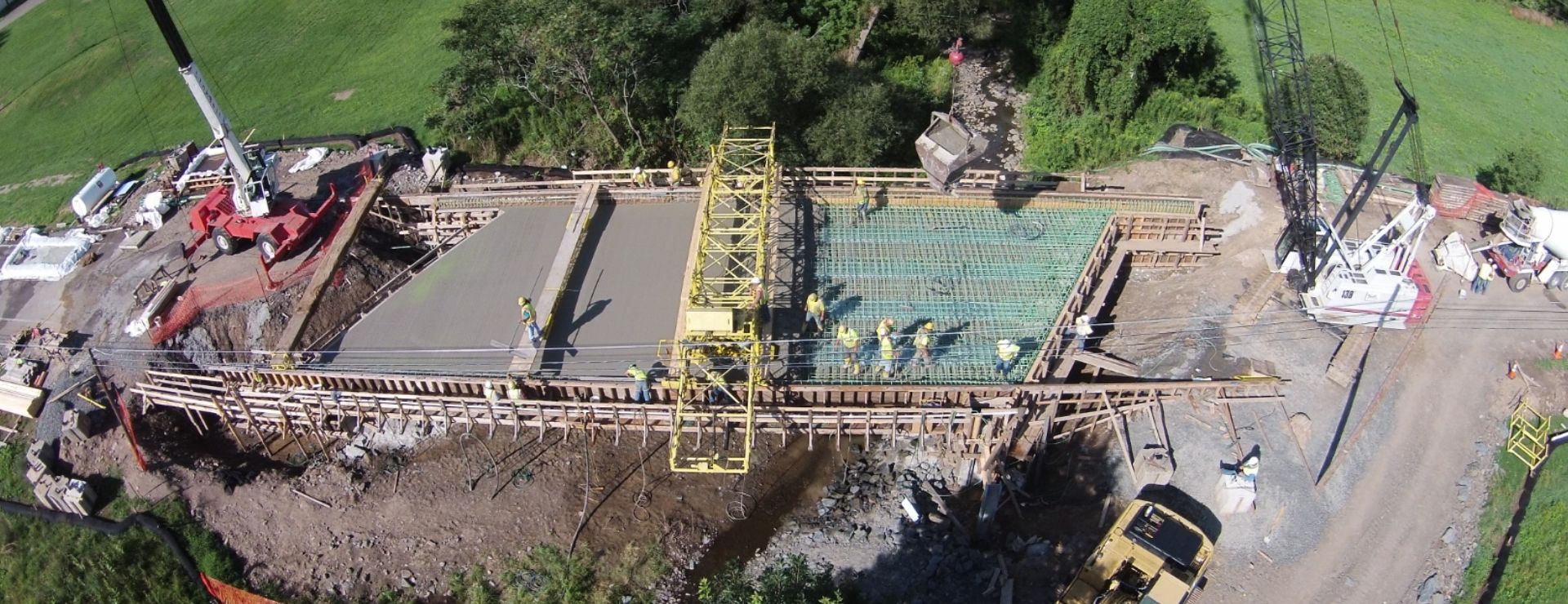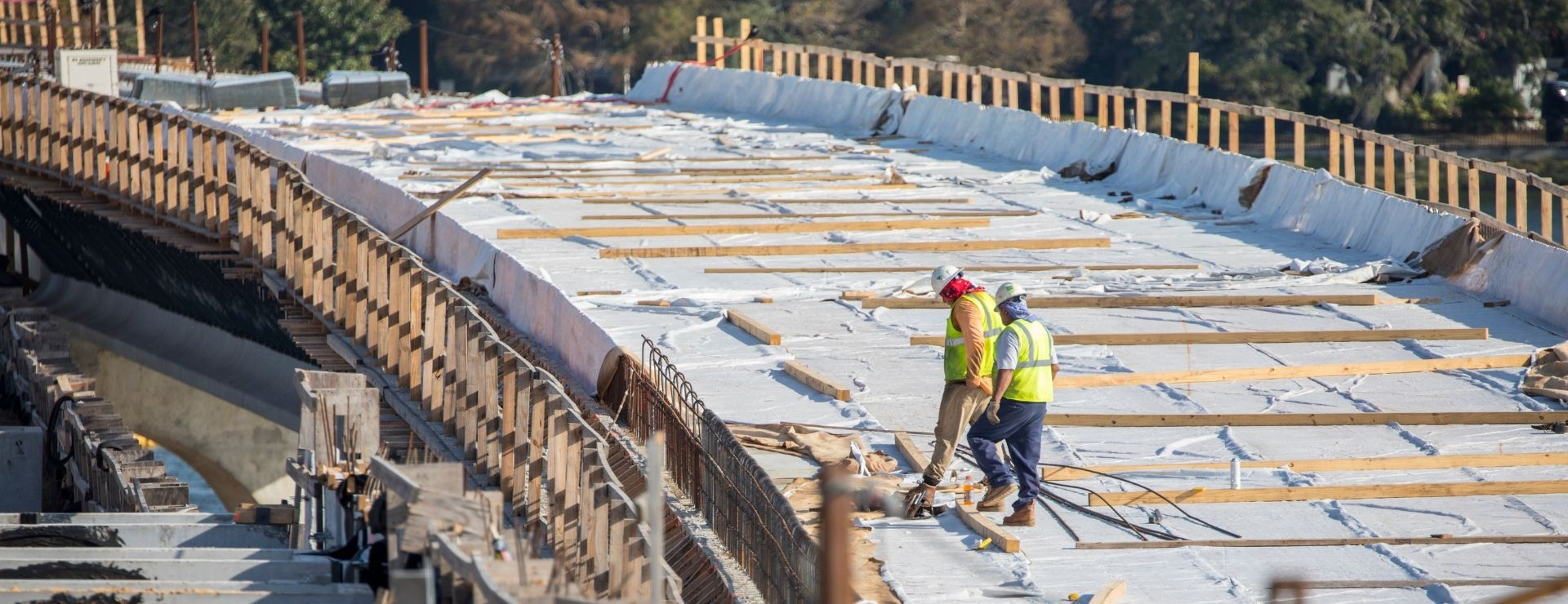
The need for federal infrastructure funding and America’s aging bridges are pressing issues. Granite is working on the Rapid Bridge Replacement Project in Pennsylvania. This Harrisburg bridge is one of 559 bridges being rebuilt, upgraded and/or replaced. (Photo courtesy of Granite)
Originally posted on FasterBetterSafer, the blog of Americans for Transportation Mobility
It’s a Friday afternoon after a week of frigid temperatures and winter storms and Gary Johnson is speaking with the Americans for Transportation Mobility (ATM) Coalition about the necessity for viable and sustainable federal transportation investment.
As Vice President of Land & Quarry in the Construction and Materials Operations Group of infrastructure leader Granite Construction Co. (Granite), Johnson has both a micro and macro view of the increasingly prescient concerns of traffic congestion, aging infrastructure, and insufficient federal investment.
Currently, Granite is a member of a team that is completing work to rebuild, replace and/or upgrade 559 bridges in Pennsylvania alone. Yes, five hundred and fifty-nine.
“When a state contracts with somebody to rebuild 500 existing bridges, you’re not really adding capacity,” explains Johnson. “You’re maintaining infrastructure that hasn’t been maintained in years. That’s why it’s so important that we get more federal funding and long-term sustainable funding that maintains but also adds capacity.”
Pennsylvania’s bridges are only one harbinger of why America needs to modernize and grow its surface transportation. With the condition of the network having declined both nationally and globally, old bridges, bad roads and underfunded public transit are sadly becoming as American as apple pie and baseball.
Granite is a diversified construction and construction materials company based in Watsonville, Calif., that works throughout the nation.
Johnson provides a few examples of Granite’s work along with lagging funding to discuss needs throughout the nation: a project partnership on an Interstate 4 stretch in Orlando; crucial $3 billion work rebuilding the Tappan Zee Bridge in New York; and the Riverside County (Calif.) Transportation Commission waiting on $2 billion in federal funding on four major projects.
“This needs to happen. These projects need to come online. They will provide, certainly, jobs early. But the surface transportation [portion] — so much of our goods coming out of the ports — are moved by trucks on Interstate 10 and on Interstate 15 east and north,” adds Johnson. “And that’s an example of projects that are ready and they’re just waiting on funding. They’ve been planned and they’ve been environmentally reviewed. Some of them have been designed, and other ones still need design. But there are roughly 700 cities that have projects like that across the U.S. and they’re just waiting on funding.”
The aggregates sector, along with other industries tied to transportation infrastructure, is a jobs creator and economic driver. Every dollar of wages earned in the industry generates an additional $4 of wages in other industries, according to the National Stone, Sand & Gravel Association (NSSGA), of which Granite is a member.
Johnson has worked for 19 years for the nearly century-old company and notes that diversity and inclusion have emerged through the years as central to its operations. Granite employs 9,200 people and has offices in more than 75 locations throughout the United States, Canada and Mexico. The company operates 76 construction materials facilities throughout the west, producing asphalt concrete, concrete aggregates, base rock, chip seal and slurry seal aggregate, and other specialty rock and sands.
Granite works on a range of infrastructure efforts, including rail and water systems, airports and ports. But roads and construction materials have always been building blocks of its success. Johnson says the publicly traded business produced enough aggregate last year to build close to 2,000 lane miles of highway.
Looking Forward
Infrastructure, which includes surface transportation, is emerging as a policy platform for federal lawmakers. The Biden Administration espouses the need for a bold and broad legislative package.
In August, USA Today reported that, based on U.S. Bureau of Economic Analysis, national statistics were the worst since the government began keeping records in 1947. However, Dallas Federal Reserve President Robert Kaplan recently said he expects the economy to grow at about a 5 percent pace in 2021 and Wall Street experts have been positive about an ambitious infrastructure vision.
While many refer to infrastructure investment, including stimulus dollars and a focus on climate change, as a way to resuscitate America’s struggling economy, the truth is the country needed another multi-year federal infrastructure bill prior to COVID-19.

Granite’s employees are essential workers helping keep our nation moving forward through key transportation improvements that connect varying regions of America. Infrastructure work by Granite employees include the I-4 Ultimate project in Orlando. (Photo courtesy of Granite)
The American Society of Civil Engineers (ASCE), in its just-released America’s Infrastructure Report Card 2021, shows a funding gap of $1.2 trillion for surface transportation. That number is for cumulative investment needs by system based on current trends, extended to 2029. And, unfortunately, America is already losing on this front to other nations, including China and Russia, says Johnson.
“Transportation funding needs to be sustainable. Number one, it needs to be user-based, whether it’s a VMT [Vehicle Miles Travelled] or gas tax or a tax on tires or a tax on batteries or a tax on freight. … It shouldn’t rely upon general fund money. If it’s user-fee-based then transportation departments can do long-term planning,” offers Johnson. “Granite Construction or another company that buys asphalt plants or aggregate plants or rolling stock, we have to depreciate that over five, seven, 10, 15, 20 years. It’s tough to make a commitment to a lot of capital if you don’t see the commitment down the road for the opportunity to use that capital to get the return on the investment. The U.S. has fallen drastically behind in maintaining and upgrading our infrastructure.”
The aggregates industry is constantly evolving. Early this year Granite opened its Solari Aggregate Plant in Arvin, Calif., which was an infill undertaking. There, a new wash plant creates concrete aggregates while minimizing the demand for fresh water. In the fall of 2020, Granite opened its Big Rock Aggregate and Asphalt Plant in Llano, Calif. The plant recycles 134,000 gallons of water per hour and optimizes the use of reclaimed asphalt pavement and warm-mix asphalt, both of which conserve raw materials and energy, cut emissions and improve conditions for workers.
Associations and companies that work in surface transportation have been pioneers in recycling, reclamation and establishing better and safer practices as well as building regional relationships. Granite, for example, received two 2020 NSSGA Environmental Excellence awards and one NSSGA Community Relations award.
ATM — A Constant Voice
In 2019, Business Insider published a story, with pictures, on the busiest most structurally deficient bridge in every state and the costs needed to repair them based on a report from the American Road & Transportation Builders Association (ARTBA). It’s a daunting read that proves that not shoring up infrastructure investment is a national dilemma.
As Executive Director of ATM, I have the honor of meeting or learning about important stakeholders such as Granite and Americans like Johnson. They are the lifeblood of our nation and their work provides momentum during these difficult times.
Sustainable and long-term funding has been an ongoing focus for ATM members. Twenty years ago, the Coalition formed after bringing the business and labor sectors together but it also wanted to engage the public. They are the users of an immense system that is linked to their quality of life, supports small and large companies, and activates communities, interstate commerce and global trade.
Separately, state and local public-education initiatives have led to voters in states and municipalities throughout America passing legislation to create transportation funding streams. Johnson points out that California raised its gas tax in 2017.
But Americans need Washington, D.C., to do its job too.
We know these things:
- While our nation faced massive unemployment, essential workers and those in the transportation infrastructure sector, such as Granite employees, went to work to keep America moving forward;
- The nation’s transportation infrastructure is funded by local, state and federal governments and the private sector, but federal funding languishes;
- Revenue is derived from a federal gas tax — a fee that has not been raised since 1993;
- General funds have been used to cover falling Highway Trust Fund (HTF) receipts;
- Multiple revenue generators need to be examined; and
- Our elected leaders can work on a bipartisan basis to provide solutions and long-term investment to rebuild a national transportation system established more than 70 years ago.
As John F. Kennedy said, “Today the challenge of political courage looms larger than ever before.”
President Biden and new Secretary of Transportation Pete Buttigieg have placed infrastructure as a policy priority and so have members of Congress. ATM thanks them as we forge ahead with hope.
NSSGA is a member of the ATM.
Tags: Americans for Transportation Mobility, ATM, Ed Mortimer, FasterBetterSafer, Granite, PA, Pennsylvania






 RSS Feed
RSS Feed